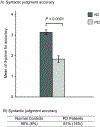A dissociation between syntactic and lexical processing in Parkinson's disease
- PMID: 31777416
- PMCID: PMC6880793
- DOI: 10.1016/j.jneuroling.2019.03.004
A dissociation between syntactic and lexical processing in Parkinson's disease
Abstract
Parkinson's disease (PD), which involves the degeneration of dopaminergic neurons in the basal ganglia, has long been associated with motor deficits. Increasing evidence suggests that language can also be impaired, including aspects of syntactic and lexical processing. However, the exact pattern of these impairments remains somewhat unclear, for several reasons. Few studies have examined and compared syntactic and lexical processing within subjects, so their relative deficits remain to be elucidated. Studies have focused on earlier stages of PD, so syntactic and lexical processing in later stages are less well understood. Research has largely probed English and a handful of other European languages, and it is unclear whether findings generalize more broadly. Finally, few studies have examined links between syntactic/lexical impairments and their neurocognitive substrates, such as measures of basal ganglia degeneration or dopaminergic processes. We addressed these gaps by investigating multiple aspects of Farsi syntactic and lexical processing in 40 Farsi native-speaking moderate-to-severe non-demented PD patients, and 40 healthy controls. Analyses revealed equivalent impairments of syntactic comprehension and syntactic judgment, across different syntactic structures. Lexical processing was impaired only for motor function-related objects (e.g., naming 'hammer', but not 'mountain'), in line with findings of PD deficits at naming action verbs as compared to objects, without the verb/noun confound. In direct comparisons between lexical and syntactic tasks, patients were better at naming words like 'mountain' (but not words like 'hammer') than at syntactic comprehension and syntactic judgment. Performance at syntactic comprehension correlated with the last levodopa equivalent dose. No other correlations were found between syntactic/lexical processing measures and either levodopa equivalent dose or hypokinesia, which reflects degeneration of basal ganglia motor-related circuits. All critical significant main effects, interactions, and correlations yielded large effect sizes. The findings elucidate the nature of syntactic and lexical processing impairments in PD.
Keywords: Parkinson’s disease; dopamine; hypokinesia; language; lexicon; syntax.
Figures




Similar articles
-
Sex, dopamine, and hypokinesia: A study of inflectional morphology in Parkinson's disease.Neuropsychology. 2019 May;33(4):508-522. doi: 10.1037/neu0000533. Epub 2019 Feb 18. Neuropsychology. 2019. PMID: 30777766
-
Sentence production in Parkinson's disease.Clin Linguist Phon. 2018;32(9):804-822. doi: 10.1080/02699206.2018.1444791. Epub 2018 Mar 1. Clin Linguist Phon. 2018. PMID: 29494261
-
The representation of lexical-syntactic information: evidence from syntactic and lexical retrieval impairments in aphasia.Cortex. 2012 Oct;48(9):1103-27. doi: 10.1016/j.cortex.2011.05.024. Epub 2011 Jun 14. Cortex. 2012. PMID: 21798529
-
Representation and processing of mass and count nouns: a review.Front Psychol. 2014 Jun 11;5:589. doi: 10.3389/fpsyg.2014.00589. eCollection 2014. Front Psychol. 2014. PMID: 24966849 Free PMC article. Review.
-
Action/Verb processing: Debates in neuroimaging and the contribution of studies in patients with Parkinson's disease.Dement Neuropsychol. 2014 Jan-Mar;8(1):3-13. doi: 10.1590/S1980-57642014DN81000002. Dement Neuropsychol. 2014. PMID: 29213873 Free PMC article. Review.
Cited by
-
Speech dysfunction, cognition, and Parkinson's disease.Prog Brain Res. 2022;269(1):153-173. doi: 10.1016/bs.pbr.2022.01.017. Epub 2022 Feb 9. Prog Brain Res. 2022. PMID: 35248193 Free PMC article. Review.
-
Plasticity of sentence processing networks: evidence from a patient with agrammatic variant of primary progressive aphasia (PPA).Neurocase. 2021 Feb;27(1):39-56. doi: 10.1080/13554794.2020.1862241. Epub 2020 Dec 30. Neurocase. 2021. PMID: 33378229 Free PMC article.
-
Classifying Parkinson's Disease Patients With Syntactic and Socio-emotional Verbal Measures.Front Aging Neurosci. 2020 Nov 23;12:586233. doi: 10.3389/fnagi.2020.586233. eCollection 2020. Front Aging Neurosci. 2020. PMID: 33328964 Free PMC article.
-
Language impairment in Parkinson's disease: fMRI study of sentence reading comprehension.Front Aging Neurosci. 2023 Mar 9;15:1117473. doi: 10.3389/fnagi.2023.1117473. eCollection 2023. Front Aging Neurosci. 2023. PMID: 36967818 Free PMC article.
-
HD-tDCS over motor cortex facilitates figurative and literal action sentence processing.Neuropsychologia. 2021 Aug 20;159:107955. doi: 10.1016/j.neuropsychologia.2021.107955. Epub 2021 Jul 9. Neuropsychologia. 2021. PMID: 34252418 Free PMC article.
References
-
- Abrevaya S, Sedeño L, Fitipaldi S, Pineda D, Lopera F, Buritica O, … Trujillo N (2017). The road less traveled: alternative pathways for action-verb processing in Parkinson’s disease. Journal of Alzheimer’s Disease, 55(4), 1429–1435. - PubMed
-
- Angwin AJ, Chenery HJ, Copland DA, Murdoch BE, & Silburn PA (2005). Summation of semantic priming and complex sentence comprehension in Parkinson’s disease. Cognitive Brain Research, 25(1), 78–89. - PubMed
-
- Angwin AJ, Dissanayaka NN, Moorcroft A, McMahon KL, Silburn PA, & Copland DA (2017). A neurophysiological study of semantic processing in Parkinson’s disease. Journal of the International Neuropsychological Society, 23(1), 78–89. - PubMed
-
- Ansari NN, Naghdi S, Hasson S, Valizadeh L, & Jalaie S (2010). Validation of a Mini-Mental State Examination (MMSE) for the Persian population: a pilot study. Applied neuropsychology, 17(3), 190–195. - PubMed
-
- Assi SM. Persian Linguistic Database [Internet] Retrieved from http://pldb.ihcs.ac.ir/. from Institute for Humanities and Cultural Studies http://pldb.ihcs.ac.ir/
Grants and funding
LinkOut - more resources
Full Text Sources
